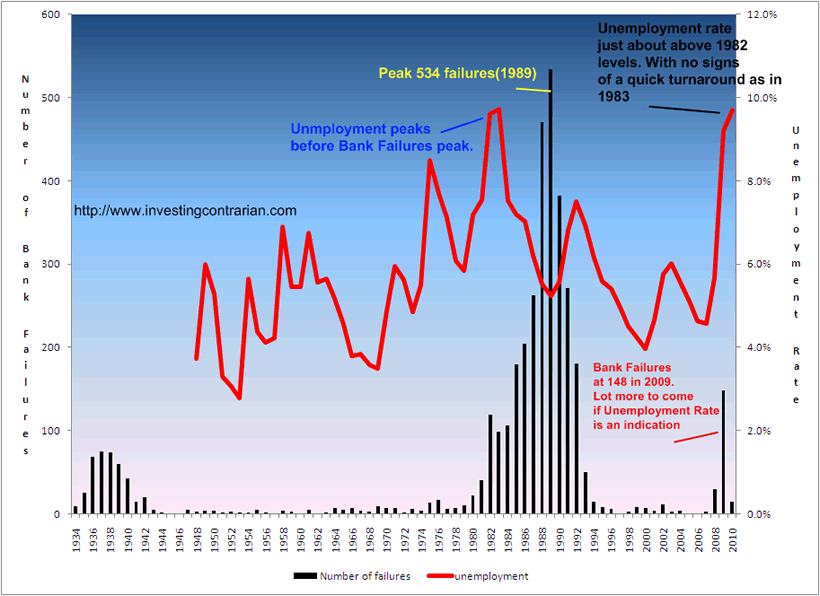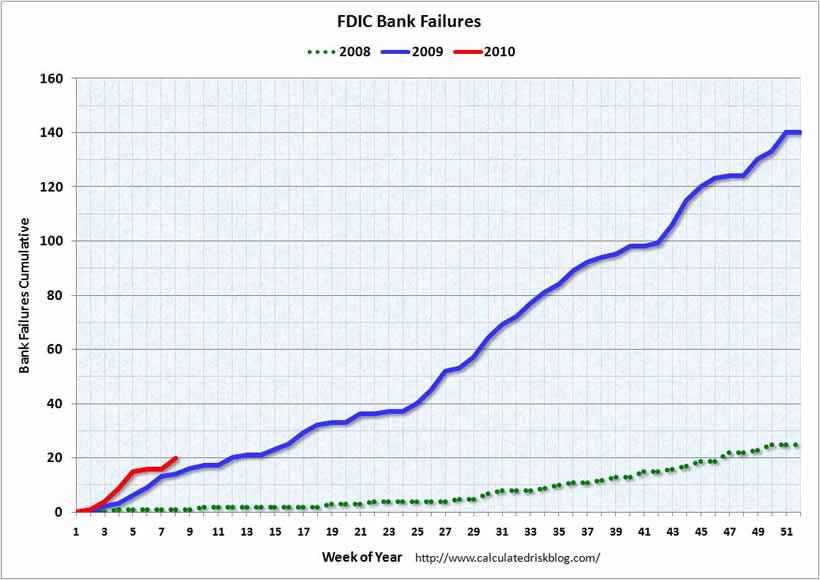Results 1 to 1 of 1
Thread Information
Users Browsing this Thread
There are currently 1 users browsing this thread. (0 members and 1 guests)
-
02-22-2010, 04:51 AM #1Senior Member


- Join Date
- May 2007
- Location
- South West Florida (Behind friendly lines but still in Occupied Territory)
- Posts
- 117,696
U.S. 1800 Bank Failures Financial Tsunami on Horizon
U.S. 1800 Bank Failures Financial Tsunami on Horizon
Economics / Credit Crisis 2010 Feb 21, 2010 - 08:45 AM
By: Fresbee
CalculatedRisk predicts 2010 to account for more number of failures than 2009 but lesser than the peak of 534 in 1989.
My prediction is the FDIC will close more banks in 2010 than in 2009 (more than 140), but fewer banks than in 1989 â peak of the S&L crisis (534 banks).
I do not disagree. But I think there is a need to understand how deep the rot is and how long before we see stabilization.
Unemployment and Bank Failures
A study into historical relation between the Saving and Loan crisis of 1982 to 1989 and unemployment rate, reveals that Bank failures take years to peak after Unemployment rate has peaked. Unemployment rate peaked in 1981 and steadily fell after that. At the same time, Bank failures mounted with nearly 2000 banks brought to their knees in about 6 years with 1989 accounting for nearly 534 of them.

The graph above explains that we can clearly be prepared for a flurry of Bank failures beginning 2009 and stretching well into 2015. I am a lot more bearish than most FDIC analysts who have looked at individual bank lists and just forcasted over 600 banks to be on the list to failures. Calculatedrisk maintains an updated list of Problem Banks at 617 as of Feb 19 2010. Latest release from FDIC:
The Unofficial Problem Bank List increased by a net of 12 institutions this week with 15 additions and 3 removals. However, aggregate assets fell by about $500 million to $329 billion.
Removals include two of the four institutions that failed on Friday â La Jolla Bank, FSB ($3.8 billion) and Marco Community Bank ($138 million). It appears that the other failures â George Washington Savings Bank, and The La Coste National Bank were not subject to any formal enforcement action.
The other removal was Hiawatha National Bank ($45 million) as the OCC terminated a Formal Agreement in April 2009 but waited until this month to disclose the termination.
Among the 15 additions are National Bank of Commerce, Superior, WI ($573 million); The Farmers National Bank of Prophetstown, Prophetstown, IL ($410 million); and The Farmers National Bank of Buhl, Buhl, ID ($386 million), which is the first appearance of an Idaho-based institution on the list.
As anticipated in the February 5th commentary, Palm Desert National Bank came back on the list this week as the OCC issued a Consent Order after terminating a Formal Agreement.
The Year 2009 that was

2010 began with a whimper for Bank Failures as the first week almost gave us the illusion that maybe and just maybe, the problem might just have solved itself as zero failures were reported. It was never going to be that easy, was it?
As the graph (courtesy friends at calculated risk), shows, a few weeks into 2010, the number of failures curve has already picked up steam and we see the red curve blasting away. I personally expect at over 200 failures this year and that is a conservative figure.
The Real Story
The question that keeps bogging most analysts, is how ugly is the FDIC problem going to be? Well my view is that it is going to be far more ugly than when Lehman went down. And this time not even God will want to help the system. (Colloquially borrowing Paulson words from the book âTOO BIG TO FAILâJoin our efforts to Secure America's Borders and End Illegal Immigration by Joining ALIPAC's E-Mail Alerts network (CLICK HERE)


 LinkBack URL
LinkBack URL About LinkBacks
About LinkBacks




 Reply With Quote
Reply With Quote

Arizona GOP pushing tough, new border policies, but faces strong...
05-05-2024, 10:24 AM in illegal immigration News Stories & Reports